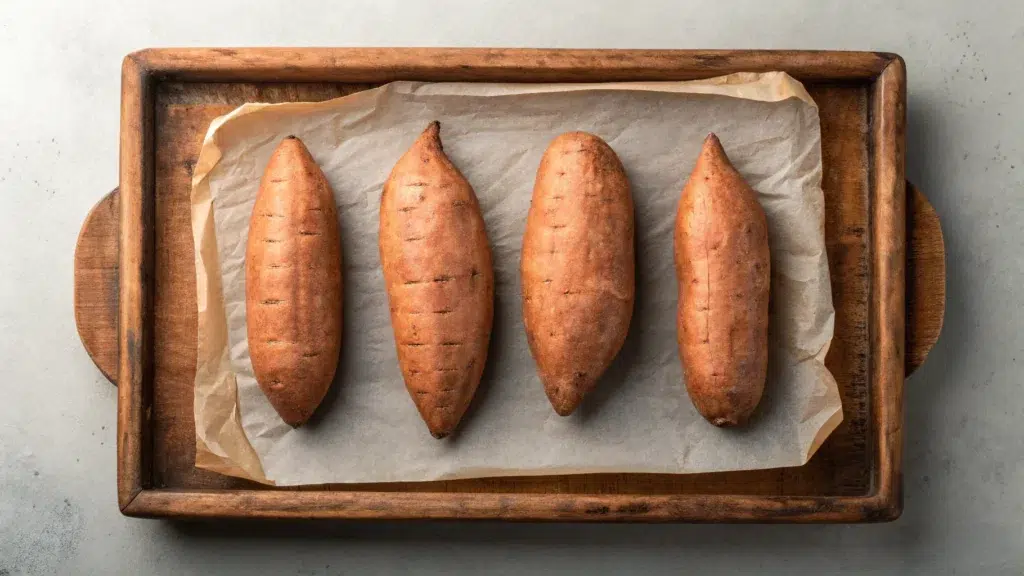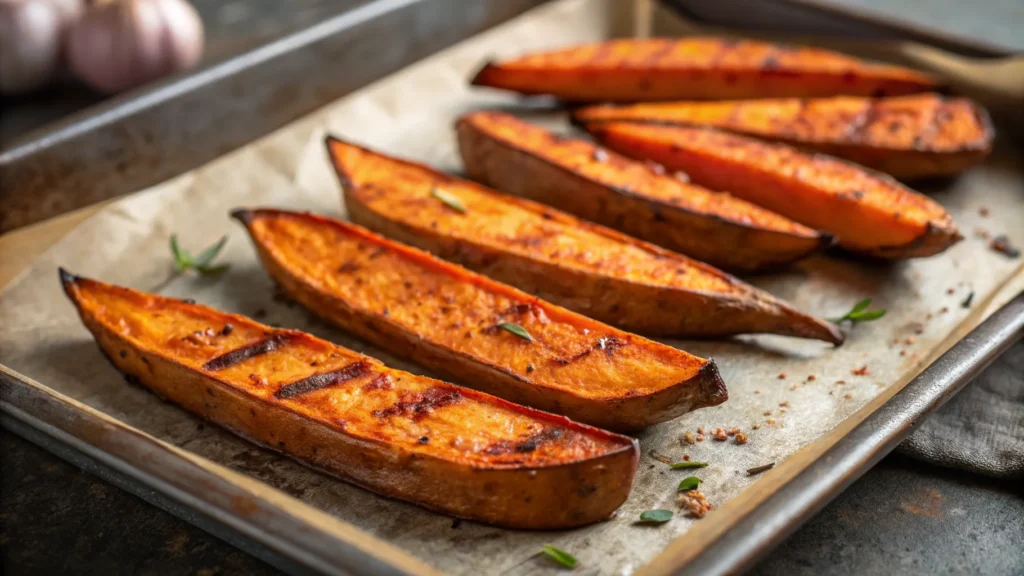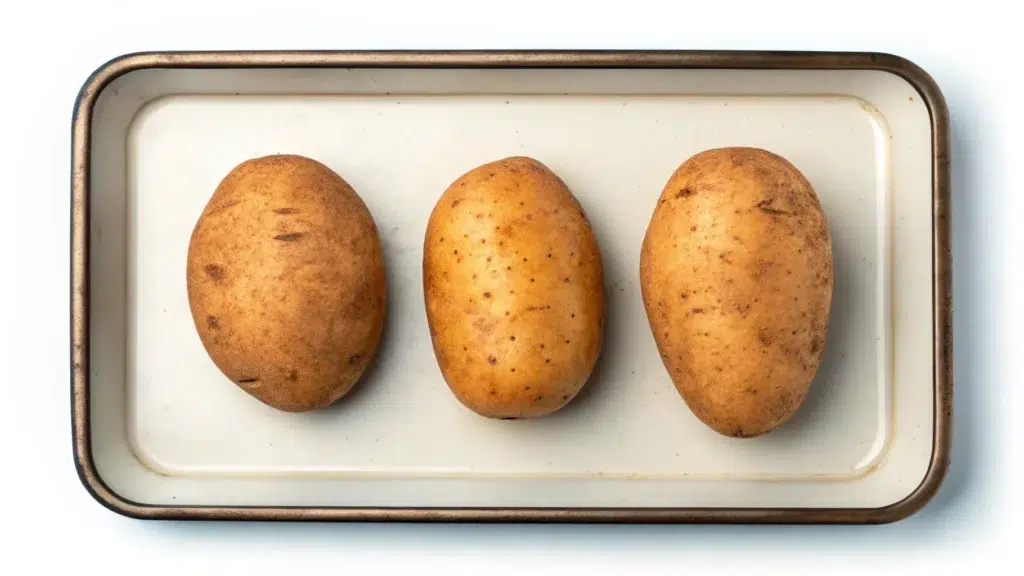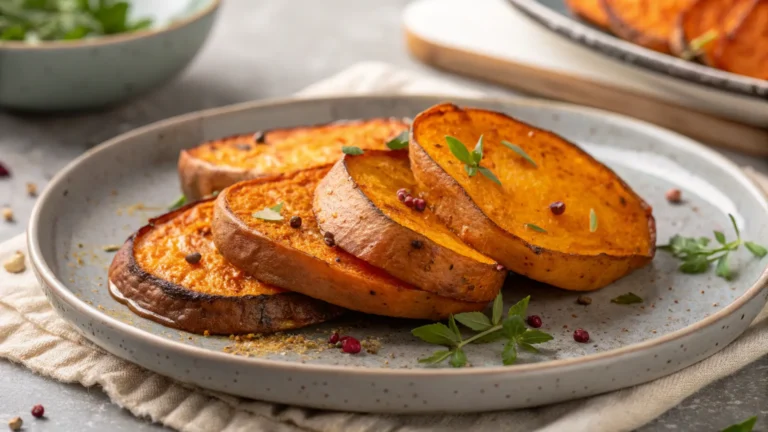Sweet potatoes are a beloved kitchen staple, but many people wonder, “How do you know when a sweet potato is fully cooked?” Cooking them to perfection can make all the difference, whether you’re roasting, boiling, or baking. This guide will walk you through simple methods to check for doneness, tips to avoid common mistakes, and creative ways to serve this versatile root vegetable.
From tried-and-true techniques like the fork test to understanding how temperature affects doneness, you’ll learn practical tips to ensure perfect sweet potatoes every time. Plus, we’ll explore what factors affect cooking time, the benefits of this nutrient-packed root veggie, and even how to store leftovers without losing their texture or flavor.
So, if you’ve ever wondered, “How do you know when a sweet potato is fully cooked?”—you’re in the right place. Let’s dive in!
The Importance of Cooking Sweet Potatoes Perfectly
Sweet potatoes aren’t just tasty—they’re nutritional powerhouses. Cooking them properly is the key to preserving their rich flavor, creamy texture, and all those good-for-you nutrients.
Why Cooking Sweet Potatoes Fully Is Essential
Cooking sweet potatoes thoroughly unlocks their natural sweetness and makes them easy to eat. Undercooked sweet potatoes can taste starchy and unpleasantly dense. Meanwhile, overcooking can leave them overly soft or even watery. A perfectly cooked sweet potato should strike the right balance: soft, tender, and slightly caramelized on the edges.
When cooked to perfection, sweet potatoes are versatile enough to star in both savory and sweet dishes—from roasted wedges to creamy casseroles. Proper cooking also ensures that their high vitamin A content stays intact, providing vital nutrients that benefit your skin, eyes, and immune system.

Common Pitfalls of Overcooking or Undercooking Sweet Potatoes
It’s easier than you think to miss the mark with sweet potatoes. Cook them too little, and you’re left with hard, unappetizing chunks that are tough to chew. Leave them in the oven or boiling pot too long, and they’ll turn into mush, losing their delightful texture.
Here’s what to avoid:
- Overcooking: This often happens when baking at too high a temperature or forgetting to check on them. Overcooked sweet potatoes may split open, releasing moisture and leaving them overly soft.
- Undercooking: This can occur if you cook large sweet potatoes without slicing them into smaller, evenly sized pieces. The center may stay firm while the outer layers soften, creating uneven results.
Cooking sweet potatoes perfectly isn’t rocket science, but it does require a little know-how. With the tips and tricks in this guide, you’ll master the art of perfect sweet potatoes every time.
Factors That Affect Cooking Time
Cooking sweet potatoes might seem straightforward, but the time it takes to achieve that perfect texture depends on a variety of factors. Whether you’re roasting, boiling, or baking, understanding these elements can help you avoid guesswork and cook your sweet potatoes to perfection.
Size and Shape of Sweet Potatoes
One of the biggest factors influencing cooking time is the size and shape of the sweet potato. Larger sweet potatoes naturally take longer to cook than smaller ones. Similarly, whole sweet potatoes will take more time than sliced or diced ones because heat has to penetrate through the dense, unbroken flesh.
For instance, if you’re baking a whole sweet potato, it can take up to an hour in the oven at 425°F. By contrast, sweet potato wedges or cubes might only need about 30 minutes. If you’re wondering, “How do you know when a sweet potato is fully cooked?” size plays a huge role. Smaller pieces are easier to test for doneness using methods like the fork or touch test.

Cooking Method: Boiling, Baking, or Roasting
The way you cook your sweet potatoes significantly affects how long they take. For example:
- Boiling is one of the fastest methods, especially for cubed sweet potatoes. It usually takes 20–30 minutes.
- Baking sweet potatoes whole can take 45 minutes to an hour, depending on their size.
- Roasting sweet potato pieces at high heat (e.g., 425°F) caramelizes the edges for added flavor and usually takes 25–35 minutes.
Choosing the right method depends on your recipe and preferences. If you prefer crispy edges, roasting is your best bet. But for soups or mashes, boiling might be quicker and more convenient.
Wrapping and Temperature Variations in the Oven
Wrapping sweet potatoes in foil can speed up baking time slightly by trapping steam and retaining moisture. However, this method prevents the outer skin from becoming crisp and caramelized. On the other hand, baking without foil allows the natural sugars to caramelize, creating a rich, slightly charred flavor.
Also, oven temperature makes a big difference. Lower temperatures (e.g., 350°F) are gentler but take longer, while higher temperatures (425°F or more) cook sweet potatoes faster but require more attention to avoid overcooking.
Methods to Check if Sweet Potatoes Are Done
Wondering “How do you know when a sweet potato is fully cooked?” There are several reliable ways to determine doneness, no matter how you’re cooking them. Here’s a breakdown of the most effective methods.
Using the Fork Test for Quick Assessment
The fork test is one of the simplest and most popular ways to check if your sweet potatoes are ready. Insert a fork into the thickest part of the sweet potato. If it slides in easily and meets little to no resistance, your sweet potato is fully cooked. However, if the fork struggles to pierce the flesh, it needs more time.
For boiled sweet potatoes, you can do this test while they’re still in the pot. For roasted or baked ones, simply pull them out of the oven briefly for the test.
Touch Test for Texture
The touch test is great for baked or roasted sweet potatoes. Gently press the surface with a pair of tongs or gloved fingers (if the potato isn’t too hot). A fully cooked sweet potato will feel soft and pliable, with a slight give when pressed. If it’s still firm, it needs more time.
This method works especially well for smaller or halved sweet potatoes that you can check without cutting them open.
Checking Internal Temperature with a Thermometer
For a more precise method, use a cooking thermometer to check the internal temperature. Insert the thermometer into the thickest part of the sweet potato. The ideal range is 205°F to 215°F. If the temperature falls within this range, your sweet potato is perfectly cooked. Anything below 200°F likely means it’s still firm and undercooked.
This method is particularly useful when baking or roasting large sweet potatoes, as they can be tricky to assess with just the fork or touch test.
Visual Cues for Fully Cooked Sweet Potatoes
Sometimes, you can tell a sweet potato is done just by looking at it. A fully cooked sweet potato will often have a slightly puffed appearance, with juices seeping from small cracks in the skin. For roasted or baked sweet potatoes, you might also notice a golden, caramelized crust on the outside.
Keep in mind that these visual cues are best combined with other methods, especially for larger sweet potatoes or when cooking for a specific texture.
The Timing Method: Knowing When Enough Is Enough
Timing is everything when it comes to sweet potatoes. While the fork or thermometer methods are great for checking doneness, it’s helpful to know approximate cooking times as a guideline:
- Whole baked sweet potatoes: 45–60 minutes at 425°F
- Roasted sweet potato cubes: 25–35 minutes at 425°F
- Boiled sweet potato chunks: 20–30 minutes in simmering water
Setting a timer and using one of the above methods to double-check ensures that your sweet potatoes come out perfectly every time.
Benefits of Sweet Potatoes
Sweet potatoes aren’t just versatile—they’re also packed with nutrients and health benefits that make them a standout ingredient in any diet. When cooked properly, they offer both flavor and nourishment, making them a staple for many cuisines worldwide.
Nutritional Profile: Packed with Fiber and Vitamin A
Sweet potatoes are rich in vitamin A, a nutrient essential for maintaining healthy skin, vision, and immune function. They’re also a great source of dietary fiber, which aids digestion and helps keep you feeling full longer. Additionally, they contain potassium, vitamin C, and several antioxidants that contribute to overall health.
Cooking sweet potatoes the right way ensures that their nutrients remain intact. If you’ve ever asked yourself, “How do you know when a sweet potato is fully cooked?” remember that undercooking them may leave their nutrients less accessible, while overcooking can degrade certain vitamins.
Retaining Nutrients by Avoiding Overcooking
To get the most nutritional benefit, avoid overcooking sweet potatoes. Overcooked sweet potatoes may lose some of their water-soluble vitamins, like vitamin C. Instead, use methods like steaming or roasting, which preserve their nutrients better than boiling. Pairing them with a healthy fat, such as olive oil, can also enhance the absorption of their fat-soluble nutrients.
For more healthy recipe ideas, check out our article on why sweet potatoes are healthier than regular potatoes.
Troubleshooting Cooking Sweet Potatoes
Even experienced cooks sometimes face challenges with sweet potatoes. Whether you’ve accidentally overcooked them or they’re still underdone, knowing how to troubleshoot common problems can save your dish.
What to Do If You Overcook Sweet Potatoes
Overcooking sweet potatoes can leave them too soft and mushy, especially if they’ve been boiled or baked for too long. While they may not hold their shape for serving as slices or cubes, they can still be salvaged:
- Repurpose them into a mash. Add butter, cinnamon, and a touch of brown sugar for a quick side dish.
- Use them in soups or stews. Their soft texture will blend seamlessly and add a natural sweetness.
Fixing Undercooked Sweet Potatoes Without Losing Quality
Undercooked sweet potatoes often happen when cooking time is underestimated, especially for larger pieces. If you cut into a sweet potato and find it’s still hard in the middle, you can:
- Return it to the oven or pot for more cooking time.
- Slice it into smaller pieces, which will cook more quickly.
To prevent this, always use a reliable method to test doneness, such as the fork test or checking internal temperature. Wondering, “How do you know when a sweet potato is fully cooked?” These methods will help ensure even cooking every time.
Preventing Common Mistakes in Sweet Potato Cooking
To avoid issues altogether, here are some tips:
- Always preheat your oven when roasting.
- Use similar-sized pieces to ensure even cooking.
- Set a timer and check regularly for doneness.
For more kitchen tips, you might enjoy reading about why your sweet potato might be hard after microwaving.
Storing and Reheating Cooked Sweet Potatoes
After putting in the effort to cook sweet potatoes perfectly, proper storage and reheating can ensure they stay tasty and nutritious. Whether you’ve baked, boiled, or roasted them, keeping them fresh is key to enjoying them later.
Proper Storage Techniques to Maintain Freshness
To store cooked sweet potatoes, let them cool completely before transferring them to an airtight container. Refrigerated, they’ll stay fresh for up to 5 days. For longer storage, you can freeze them—mashed or sliced sweet potatoes freeze best. Be sure to wrap them tightly in freezer-safe bags or containers to avoid freezer burn.
When storing, keep in mind that the texture may change slightly over time. This is especially true for roasted sweet potatoes, which might lose some of their crisp edges after refrigeration.
The Best Ways to Reheat Sweet Potatoes
Reheating sweet potatoes properly is essential to preserve their flavor and texture. Here’s how:
- Oven Method: Wrap sweet potatoes in foil and reheat at 350°F for 15–20 minutes for even heating.
- Microwave Method: For a quicker option, heat them on high for 1–3 minutes, but cover them with a damp paper towel to retain moisture.
- Stovetop Method: For mashed sweet potatoes, heat them gently in a saucepan with a splash of water or milk to prevent sticking.
Wondering, “How do you know when a sweet potato is fully cooked?” The same principles apply when reheating—check that they’re soft and evenly warmed all the way through.
For more tips on reheating and storing, check out our guide to keeping sweet potatoes from drying out in the microwave.

FAQs About Cooking Sweet Potatoes
When it comes to sweet potatoes, people often have questions about cooking, serving, and storing them. Here are some answers to common queries to help you master this versatile root vegetable.
How Do You Know When a Sweet Potato Is Fully Cooked?
This is one of the most frequently asked questions, and for good reason. Fully cooked sweet potatoes will feel soft to the touch, with a fork sliding in easily when tested. You can also use a thermometer to check that the internal temperature is between 205°F and 215°F. Visual cues, like slightly puffed skin or caramelized juices, can also confirm doneness.
Can I Overcook Sweet Potatoes?
Yes, overcooking sweet potatoes is possible. When left too long in the oven or boiling pot, they can become mushy and overly sweet. While they’re still edible, they may not hold their shape for serving. To avoid this, follow cooking times carefully and test for doneness early.
What Happens If Sweet Potatoes Are Undercooked?
Undercooked sweet potatoes can be hard, starchy, and unpleasant to eat. They’re also difficult to mash or incorporate into recipes. If this happens, simply continue cooking them until they’re tender all the way through.
What’s the Best Way to Cook Sweet Potatoes?
There’s no single “best” method—it depends on your recipe and preferences. Roasting enhances their natural sweetness, boiling is fast and simple, and steaming preserves their nutrients. Try different methods to see what you like best!
How Should I Store Leftover Cooked Sweet Potatoes?
As mentioned in Part 6, refrigerate cooked sweet potatoes in airtight containers for up to 5 days. Freezing is another option, especially for mashed varieties.
Common Mistakes to Avoid When Cooking Sweet Potatoes
Cooking sweet potatoes may seem simple, but there are a few common pitfalls that can ruin your dish. Learning to sidestep these mistakes ensures your sweet potatoes come out perfect every time.
Overcooking or Undercooking Sweet Potatoes
One of the biggest issues is misjudging the cooking time. Overcooked sweet potatoes can become mushy, losing their structure and making them hard to serve. On the other hand, undercooked sweet potatoes are dense and starchy, making them unpleasant to eat.
To avoid these mistakes, always test for doneness. If you’ve wondered, “How do you know when a sweet potato is fully cooked?” remember to use the fork test or a thermometer to check for an internal temperature of 205°F to 215°F.
Skipping Prep Steps Like Peeling or Slicing
Not prepping sweet potatoes correctly can lead to uneven cooking. For instance, failing to slice large sweet potatoes into smaller, even pieces means they won’t cook at the same rate. Also, leaving the skin on when boiling can slow down the process.
For the best results, always peel and slice sweet potatoes uniformly when boiling or roasting smaller pieces. This ensures they cook evenly and reduces the risk of undercooked centers.
Creative Ways to Serve Sweet Potatoes
Once your sweet potatoes are cooked to perfection, the fun begins—deciding how to serve them! These versatile vegetables can be transformed into a wide range of dishes that are both delicious and visually appealing.
Classic Sweet Potato Side Dishes
Sweet potatoes are a fantastic side dish for almost any meal. You can:
- Mash them with butter and a pinch of salt for a creamy accompaniment.
- Roast them into crispy wedges or cubes with your favorite seasonings.
- Bake them whole, then top with sour cream, chives, or cinnamon sugar for added flavor.
Each of these methods allows the natural sweetness of the potatoes to shine while complementing other ingredients.
Sweet Potato Recipes for Special Occasions
For something a little more special, consider sweet potato dishes that stand out:
- Sweet Potato Casserole: Combine mashed sweet potatoes with brown sugar, butter, and a crunchy pecan topping.
- Sweet Potato Pie: A rich dessert that’s perfect for holidays and family gatherings.
- Stuffed Sweet Potatoes: Fill baked sweet potatoes with black beans, avocado, and a drizzle of lime crema for a creative twist.
Whether you’re keeping it simple or going all out, sweet potatoes always deliver in taste and presentation.
For additional sweet potato inspiration, check out this article on whether it’s better to boil or bake sweet potatoes.

